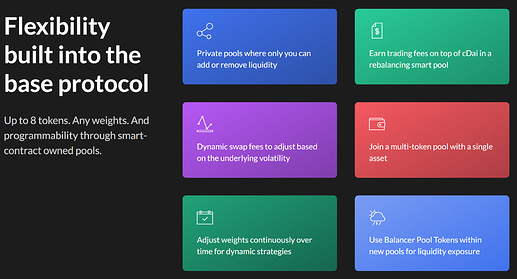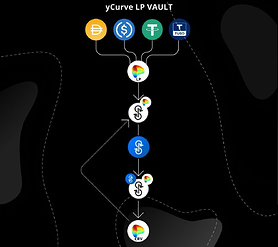Appreciate all the feedback so far everyone! My partner Medio and I have spent a lot of time thinking about the proposal we’ve put forward and wanted to share a few notes of our discussions to help the community make an informed decision.
One hurdle that PowerPool and most projects are currently facing with all the attractive yield farming initiatives popping up every week are being able to develop a sticky base. For example, you could see a scenario where the attractive yield from CVP rewards does a great job of having a lot of the DeFi governance tokens chosen added to its pools while PowerPool is the farm of the week. That being said, once rewards inevitably go down and are not as attractive as a new farm that pops up, some liquidity providers would most likely pull their assets from the pool to farm with.
If the liquidity for those governance tokens gets pulled, PowerPool’s influence can severely diminish, if not disappear entirely. Given how fluid we’ve seen liquidity be, as people chase the hot new yield farm each week, this is a serious concern.
This is a difficult thing to combat for the long term so Medio and I started brainstorming ways we could protect / hedge against this. Here are a few ideas below. These can be modified, combined, or even just leveraged as inspiration for what the community thinks will help PowerPool be successful long-term.
A Permanent Part of PowerPool
This is expanding on an idea from Medio’s original proposal for PowerPool two weeks ago.
Let’s face it. In the near term, the fees from trading leveraging PowerPool will be negligible. For the near term, most LPs for PowerPool will not be providing liquidity for the fees. They’ll be providing it for the rewards. ~80% of the total CVP supply is set to be distributed during their liquidity mining program (something we’ll comment on later). This should be more than enough yield to attract deposits even with no fees being paid out.
Rather than paying out the fees generated by the trading from the PowerPool, why not redirect it to a reserve owned by PowerPool, with the key stipulation that the assets are never sold. This way even if people pull their liquidity in the future, PowerPool has some way to maintain its influence in perpetuity to some degree.
One thing that can also be done is to have a dynamic fee structure. Where for a certain amount of time while CVP rewards are enough to incentivize liquidity to stay in the PowerPool, 100% of fees are siphoned off to the Permanent Pool. If all of a sudden fees are generating some amount of value and the CVP rewards we’re paying out aren’t attractive enough, CVP holders could potentially vote to pay out a certain % of fees to help incentivize liquidity to stay. How would we adjust the fees paid to this PowerPool? This brings me to our next point.
Leveraging Balancer’s Smart Pools
One thing we’d probably want to leverage from Balancer are their smart pools. There’s the possibility that not enough people will want to trade in their exposure to a specific DeFi gov token they’re bullish on to an equal exposure to a portfolio of them. If that’s the case, perhaps the community can not only vote on which tokens are included - but once voted in, they can vote on what % of the pool each token is. For example, if YFI SNX AAVE are voted in. One of them could be voted as an outsized portion of the pool making adding liquidity to the pool an easier pill to swallow. Also, Smart Pools have other attractive features such as adding or removing tokens, pausing swaps, and of course adjustable weights/fees.
Another thing that potentially mitigates this concern is that there are definitely a lot of investors in the markets who probably hold popular DeFi governance tokens like YFI, LEND, SNX, etc. in their portfolios already. Now these investors can deposit them into the pool, receive similar exposure, and yield farm those assets.
If you want 100% YFI exposure and the pool is only 70% or less YFI - then you’ll either not participate, or use a smaller part of your portfolio for the yield. The good thing is that investors who choose not to participate will simply boost the APY investors who are okay with this exposure will receive from CVP.
In addition to the CVP rewards they’ll receive, farmers can now take part in fast, cheap governance proposals all in 1 place across their entire portfolio, boosting engagement that wasn’t there before.
With PowerPool, you can actually build cross protocol synergies and loyalty.
Accompanied With a yVault Strategy
In the current market environment, YFI’s importance can not be understated (full disclosure: Delphi holds $YFI). The protocol is able to send flows to essentially any project of its choosing which can help bootstrap supply / demand while potentially bringing a portion of its strong community with it.
Because of this, our team has been thinking of how we can use YFI’s influence to help bootstrap protocols launching. PowerPool particularly. Here’s a vault strategy we believe could be attractive for all three parties: YFI holders, PowerPool Liquidity Providers/Farmers, and long-term CVP holders.
As we mentioned before, trading fees generated become permanent liquidity in pool. So PowerPool should want to take in as much trading volume as it can - and we leverage our liquidity mining rewards to incentivize year.finance to direct volume towards it because of this.
Take the PowerPool LP shares which represents a pseudo DeFi ETF and throw it into a vault strategy farming PowerPool’s CVP. Yes, the vault strategy sells the CVP it earns, but you keep the permanent liquidity and the yield from the vault will only keep making it deeper over time also being reflexive.
Then you keep the assets in the pool, like with the yCurve strategy, but you get that yield from farming out the LP shares. Thus, the value generated from the vault strategy selling CVP = the amount of new permanent liquidity added to the PowerPool.
This is an example of really embracing the open-naturedness of these protocols as well as the composability that has been able to be established over the past few years.
Using CVP’s Current Distribution as an Advantage
To be clear, our team was not a big fan of the initial distribution between Alpha / Beta / Gamma rounds of CVP. But this was set before we got involved into the project, so the proposal we’re suggesting is essentially a thought exercise of how we could help PowerPool succeed despite this drawback while potentially allowing us to use that distribution as a benefit.
One advantage that their initial distribution has was that it has led to a small circulating supply of CVP in the market while ballooning the FD market cap. It’s circulating market cap sits just above $20M, while it’s fully diluted market cap is close to $500M. This is clearly a lot for an early stage project that hasn’t even really launched yet, but the value of a liquidity mined DeFi ETF with layer 2 meta-governance on top should not be underestimated. Anyway, I believe we can use that high FD market cap to CVP’s benefit.
The PowerPool idea has a reflexive mechanism built in where, if the scarce supply and 1/8th target threshold for fees keep driving price higher, APY from the liquidity mining rewards also rises with it, potentially allowing us to taper this longer over time.
If the community decides to move forward with our overall proposal, we’ll also allocate time to help design the liquidity mining program for CVP. One key focus for us here will be flexibility. With the ability for PowerPool to be able to offer LPs dynamic fees via Balancer’s Smart Pools, we believe it will be important to keep some of our ammo (CVP rewards) for events we can’t forecast at the moment.
Additionally, as Medio teased in our last post - there is the possibility of the project being able to spin up multiple PowerPools (maybe one for other sectors in the future). If that’s the case, we definitely want to have a good amount of ammo set aside for the future.
The Utilization of Governance Tokens
One big challenge we were curious to get the community’s thoughts around specifically was how to think through the utilization of these governance tokens while they were in the pool.
You could lock the pool leading up to votes or use a reserve ratio type mechanism to lock a portion of tokens for longer periods of time if necessary for them to vote (e.g. x% of pool). CVP stakers can be locked for governance so that could also be counted too if the protocols were receptive and saw the benefits from the layer 2 scalability of the platform. The pool is designed for all the projects to benefit from their inclusion so perhaps certain exceptions could be granted? Strong partnerships with key projects could help PowerPool develop a stronger moat over time.
Either way, we believe time-based voting will become more and more prevalent across governance for these protocols so some further work here is needed. If anyone has any thoughts or insights here, feel free to reply here!
An Important Requirement: Strong Integrations
Lastly, getting the proper integrations in place will be key. Fortunately, PowerPool’s team has been able to execute better than most food-based meme coins on this end so far. They’ve already formed a strong partnership with Boardroom as well as xDAI for their Layer-2 capabilities.
More integrations are necessary though to really help PowerPool gain enough traction to make the move from exciting experiment to an innovative project with a lasting impact on the space.
An integration with exchange aggregators such as 1inch, Debank, and Dex.Ag could end up funneling some meaningful volume to PowerPool if it’s pools attract the depth some of these farming initiatives initially have in the past.
On the flip side, getting integrations with popular interfaces like Zapper, Frontier, and Debank will also be important. You could see a situation where if Zapper implements support for zapping in and out of the pool, PowerPool could get a liquidity boost without a major imbalance in a few assets.
“For example, I can go to Zapper and enter the PowerPool with an equal mix of all 8 tokens. But instead of individually purchasing them, I just tell Zapper how much ETH/DAI i want to sell to get into the pool and it sells my ETH for an equal amount of the 8 tokens. Extra points if Zapper can make it so i can choose any mix of the 1-8 tokens. This could skew deposits towards assets in the PowerPool that are lower than their target weight.” (cheers to one of our readers Ashwath for this suggestion btw)
Hope all these thoughts help, looking forward to hearing what everyone thinks and working together with the community to help make PowerPool as successful as possible!



